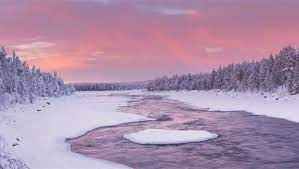Snow
Snow is a natural form of precipitation consisting of ice crystals that form in clouds when water vapor in the atmosphere freezes. These crystals cluster together to create snowflakes, which fall to the ground when they become heavy enough. The unique hexagonal structures of snowflakes form due to the molecular structure of water, making each snowflake unique.
Snow forms under specific atmospheric conditions, typically at temperatures below freezing (0°C or 32°F), though snow can fall at slightly warmer temperatures when the atmosphere is very moist. Snowfall covers landscapes in a white blanket, reflecting sunlight and often creating serene, silent scenes. Snow is also critical for water storage, as it accumulates in winter and melts in warmer months, replenishing rivers, lakes, and reservoirs.
Snow is also a key player in supporting diverse ecosystems and wildlife, particularly in colder climates. Many animals have adapted to snowy conditions for survival; for instance, arctic foxes, snowshoe hares, and ptarmigans change their fur or feathers to white during winter to camouflage with the snowy landscape, evading predators. Snow also insulates the ground beneath, trapping warmth in the soil and creating a more stable environment for plants and small animals. This natural insulation allows some organisms to survive extreme winter temperatures, as the snowpack provides a buffer that can protect roots, seeds, and even insects from freezing.
In forested areas, the snowpack provides critical support for the soil and forest floor, holding down leaves and organic matter that will decompose and enrich the soil once the snow melts. Snowmelt recharges groundwater reserves and feeds into rivers and lakes, helping to maintain water levels that are essential for aquatic life. Additionally, snow’s gradual release of water during warmer months prevents flooding and ensures a steady water supply. In mountainous regions, snow even shapes the terrain over time, as cycles of freezing and melting carve out valleys and influence the formation of glaciers.
As climate change intensifies, the decrease in snow cover is already impacting these ecological systems, disrupting seasonal patterns and endangering species that rely on snow for survival. Reduced snow cover also threatens winter economies and alters water availability, creating challenges for communities that depend on snow for agriculture, hydropower, and tourism. The future of snow remains a focal point for climate scientists and conservationists alike, as preserving seasonal snow cover is closely tied to protecting biodiversity, stabilizing water supplies, and mitigating the impacts of a warming planet.
International Research Excellence and Best Paper Awards
Visit: https://bestpaperawards.com/
#WinterWonderland
#Snowfall
#LetItSnow
#SnowyAdventures
#SnowCovered
#SnowPhotography
#SnowSeason
#FirstSnow
#Snowflakes
#WinterMagic
#SnowcappedMountains
#FreshPowder
#SnowyScenes
#SnowyDays
#SnowGlobe
#FrozenLandscapes
#Snowstorm
#InstaSnow
#WinterActivities
Facebook: www.facebook.com/profile.phpid=100087106114908
Twitter : twitter.com/bestpaperaward
Pinterest : in.pinterest.com/bestpaperaward
Linkedin : www.linkedin.com/in/esha-gupta-18b2b4245
Instagram: www.instagram.com/eshagupta__2022/




Comments
Post a Comment